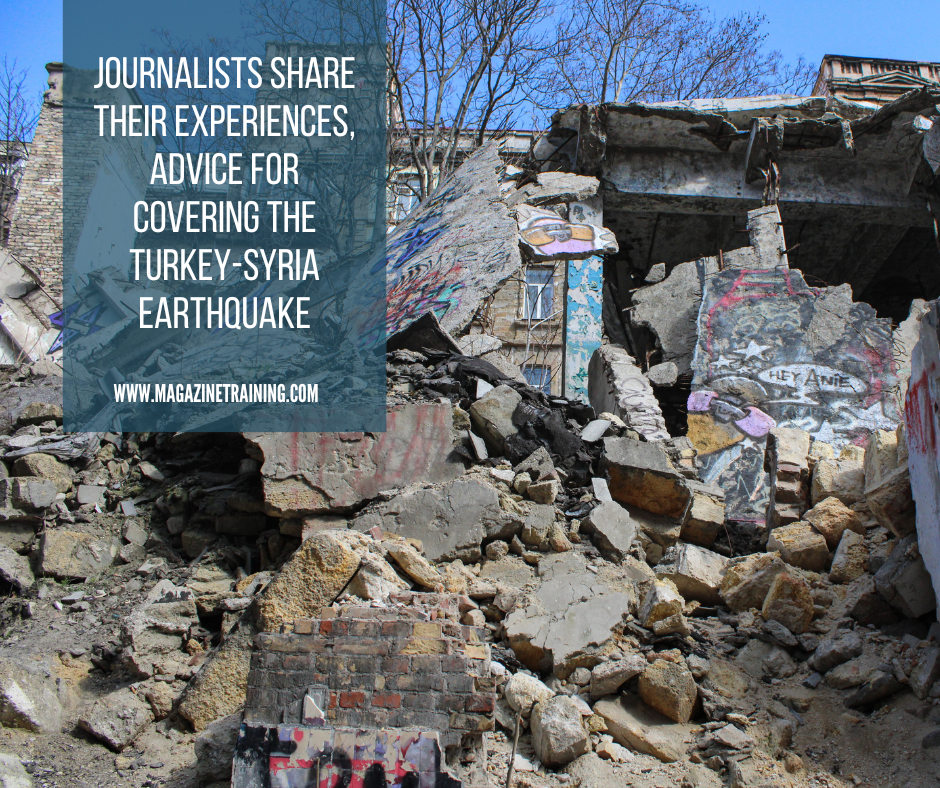
A 7.8 magnitude earthquake that rocked Turkey and Syria on February 6 has left at least 36,000 dead, and thousands more injured. Newsrooms and journalists are on the frontlines covering the destruction, while also taking to social media to share the names of missing people and contact information of organizations able to provide assistance.
I spoke with journalists in Syria, Turkey and Lebanon about their experiences during the earthquake and in its aftermath. They discussed how to responsibly report on the disaster, fact-check circulating information, and why it’s important to collaborate in times of crisis.
Witnessing the disaster
Journalists in both Turkey and Syria were directly impacted by the earthquake. “I woke up terrified as I felt that the world was shaking everywhere, and I left our house with my children and wife because I thought it might be a missile strike,” said Syrian journalist Ahmed Orabi, who was with his family in Al-Atarib in Aleppo, Syria, when the earthquake hit. “The electricity went out in the house, and we spent about six hours in my car. The weather was rainy, we heard the sound of the collapsed buildings, and we smelled destruction’s smell.”
Also in Aleppo, independent Syrian journalist Haneen Al-Sayed, described the tragic night: “I was scared so I ran out into the street with my children, husband, and mother. Stones were falling over our heads due to the collapse of our house’s upper floor.”
Even as journalists were among those affected by the immediate disaster, many rushed to help in its aftermath. Rami Muhammad, another journalist from Syria, helped rescue victims trapped under the rubble. “The extent of the destruction is frightening; at first glance, you think that you have entered an area that was targeted by atomic bombs,” he said.
Ali Al Ibrahim, an investigative journalist and co-founder of Syrian Investigative Reporting for Accountability Journalism (SIRAJ), shared how he lost relatives to the earthquake: “My uncle, his wife, and their three children remained 42 hours under the rubble until they all died.”
Media services and humanitarian stories
In Syria, which has received little international aid following the earthquake, citizens have helped search for people amid hundreds of collapsed buildings, said Khalil Ashawi, a Reuters photographer and co-founder of Frontline in Focus. Ashawi’s own parents were trapped under the rubble in Antakya, Turkey, for two days before they were rescued alive.
After ensuring that his team members, based in Syria, were safe, Ashawi had them document the earthquake with aerial photos and human-centered stories. With internet and electricity largely cut off inside Syria, others on the team traveled to the country’s border to upload the content on the website and social media.
Hadil Arja, the founder of Tiny Hand and fellow co-founder of Frontline in Focus, advised journalists to do their best to remain professional as they report on the traumatic aftermath. “Journalists in Syria and Turkey should have the willpower and determination to report events and facts with extreme professionalism and objectivity,” she said. “[They] should report people’s suffering and write humanitarian stories to transfer the voices of the affected.”
Verifying information
Misinformation proliferates during natural disasters, warned Joyce Hanna, a fact-checker with AFP. “Fake news promoters take advantage of disasters which have many shocking human photos, such as a child crying after losing his family and scenes of children under rubble,” she said. “Rumor-mongers repost old, terrifying videos that have been taken out of context to entice users to share them on social media.”
Since the earthquake, Hanna’s team has used techniques such as reverse image search tools and cutting videos into still scenes to check whether media published on the internet is recent or old content from past disasters.
“We also rely on our journalistic experience such as adding keywords to verify information, and limit the search to a specific time period, in addition to contacting our correspondents worldwide to ensure the authenticity of news and images,” Hanna said. “Don’t publish photos and videos during disasters and earthquakes until you verify their credibility, to prevent the spread of rumors.”
Related posts
Magazine Training International’s mission is to encourage, strengthen, and provide training and resources to Christian magazine publishers as they seek to build the church and reach their societies for Christ.

